Legacy blue ticks are about to be taken away - so should you pay for Twitter's subscription verification plan?
* This article was originally published here
Make Money Online Fast Discover proven ways to make money online quickly with affiliate marketing, legit side hustles, digital courses, and expert tips. Learn how to start earning today — no experience needed. Explore honest reviews of top programs, essential tools, and high-converting strategies to build income from home or anywhere in the world. Perfect for beginners, side hustlers, freelancers, and anyone ready to create real financial freedom.
Legacy blue ticks are about to be taken away - so should you pay for Twitter's subscription verification plan?
Google’s 2022 Ad Safety Report highlights the scale of moderation activity required at large platforms.
The greatest source of information about how your company’s performing is your customers.
I know that sounds obvious, but I think thousands of companies are underutilizing the value their customers can bring to their marketing and sales.
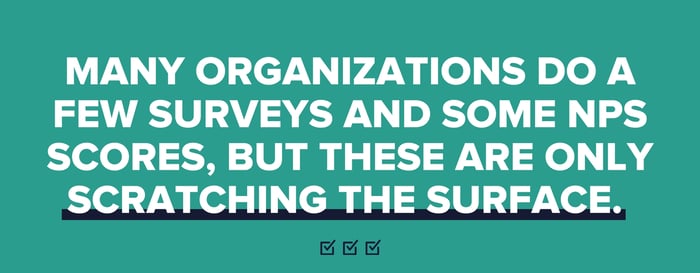
Many organizations do a few surveys and some net promoter scores (NPS), but these are only scratching the surface.
A lot of people are very cautious about bothering their customers — burdening them with requests and making them feel alienated.
And I get that – but if you approach your customers the right way, you’ll actually build a stronger bond, all while learning valuable insights to improve your sales and marketing.
Below, I’ll explain exactly what I would ask of my customers about our sales and marketing — and when I would ask it.
You can use my formula to glean as much information from them as possible. Which, in turn, will help you fine-tune your messaging and your sales process.
Let’s jump in.
Every step of the customer journey is a learning opportunity, but, in my experience, two key points get overlooked, which can provide high value to your team.
If you can have your team connect with buyers at these key touchpoints, you’ll get insights you’ve been missing.
Talk to customers right after they close.
It’s easy for marketers to stop paying attention to leads after they get passed onto the sales team, but this is a unique missed opportunity for feedback.
A newly-signed customer is the culmination of the efforts of both sales and marketing. They will have fresh insights into your messaging and outreach that may get forgotten down the line.

Talk to customers right after the service has been performed or the product has been delivered.
It’s easy for salespeople to stop paying attention after a deal is closed, but this is a missed opportunity too. A closed customer can help you audit your sales process and service experience with their perspective.
These are the touchpoints where the customer will be able to give you the most feedback on your performance.
Here’s exactly what you should ask those customers.
A customer who has just closed is at the very end of your entire marketing and sales process.
Why is this important? Whatever you did worked — Congratulations! However the lead came to you, whatever they bought, they are proof that your process was effective. Now, you want to attract more people just like them.
So, what should you ask? Here’s a run-down.
When to ask: Right after the deal closes.
How to ask: A 15-minute 1-1 meeting (as opposed to a survey or focus group)
What to ask:
The point of this conversation will be to have new customers reflect on what brought them to you and got them into your funnel. At this point, the whole customer journey is fresh in their mind, so they’ll likely be able to give you more detailed answers.
Make sure to record these meetings so you don’t lose access to the insights.
Keep in mind, you don’t need to interview every customer. For some businesses, that’s not at all reasonable. But if you sell bigger ticket items, you might only sell to a handful of buyers each quarter, so every individual purchase is a big deal for your company.
No matter what you offer or how many you sell, plan on having a few of these interviews every month. That way, you’ll have enough information to draw meaningful conclusions.
I know, salespeople already know so much about their buyers. But after the sale, they hand over the customer to the services team, or the customer gets the product, and that’s usually it. Sales reps turn their attention to their next prospects.
But sales conversations are full of promises — and sales reps should check in to make sure their promises were kept when the product was delivered or the service was rendered.
If we create an additional touchpoint, the sales team can use the relationship and trust they’ve established with a customer to get candid feedback and learn a whole more — and then apply it to future sales conversations.
When: Shortly after the product has been delivered or the service has been rendered.
How: A short survey (sent with a personal note)
What they should ask:
After the customer has completed the purchase, they’re in a great position to evaluate the whole customer experience.
Now, you might not want to survey them the very day their new product gets delivered; they might need a couple weeks. But you don’t wait too long. You want the experience to be fresh in their mind.
Prompt them to be honest. Use words that encourage them to give real feedback. You don’t want to just hear them say everything was “fine.”
I hear from too many businesses that give lip service to customer research but don’t actually get all that much out of it. They have NPS as a core vital they’re tracking, and they think that’s sufficient.
It’s not.
Use these touchpoints to get honest feedback on your sales and marketing processes so you can better serve your future customers.
.jpg?width=700&height=2198&name=Learning-From-Customer-Touchpoints%20(1).jpg)
And if you want to learn more about optimizing your sales and marketing, join IMPACT’s Zach Basner and Nick Bennett every week for a free session focusing on a current issue we see our clients facing.
A big change to try and drive Twitter Blue take-up - but will it work?
We live in a buyer's market.
Thanks to the internet, buyers can do their research independently and learn all about your product or service without ever speaking to a member of your sales team. Heck, with Yelp, Angi, and G2 among others, they don't even have to turn to you to necessarily get that information.
In other words, power is firmly in the hands of the consumer to choose where, how, and with whom they spend their money.
This is one of the many reasons marketers and businesses as a whole need to be putting their customer's interests first in everything they do.
We need to answer their most urgent questions, give them more of what they want and need to see and do, relieve their pain points, and help them make the best decisions for themselves.
Putting the customer first is how you can not only build trust with potential buyers, but close more sales.
But what does this look like?
Collecting customer feedback can be one the easiest and most effective ways to inform and shape your strategy.
Why is customer feedback so important?
Whether you’re offering a product, service, or even both, knowing how your customers feel about you is essential.
Customer feedback — be it offered explicitly or gathered through data and behavior tracking tools — can help you understand where you’re struggling and succeeding and course-correct problems.
With feedback from your customers you’ll be able to:
But to be successful in this any of this, you first need to effectively gather these insights. A good customer feedback tool can help.
While there are many customer feedback platforms and tools out there, not every one will be the best fit for any company.
Depending on your needs and the nature of your product and your marketing and sales strategies, you may find yourself needing a specific solution.
In no particular order, here are nine of the best customer feedback tools (covering a wide range of needs):
Typeform is known for its unique approach of displaying one question at a time in its finished products. It's quite popular and with good reason — it's extremely versatile.

Brands have used it to create quizzes and dynamic interactive experiences on their websites, but it can also be used to create forms, surveys, and quizzes to gather feedback from your customers.
For example, you can inquire about what they like about your brand, products, and services, and what needs improvement.
To add to its sleek design, Typeform also has built-in video and photo libraries that let you add more visual depth and context to surveys and questions.
Price: Free to get started, then $25-83 per month depending on the plan
With more and more business being done digitally, it's important to know how you stack up in that department. In terms of customer feedback, UserTesting is unique in that it focuses on your digital presence, specifically your websites, apps, and platforms.
It's also not simply a survey or form customers "fill out" or answer.
With UserTesting, you actually get to see recordings of how a customer interacts with what you've created. This means you get to see their facial expressions and hear any verbal reactions in addition to their clicks and navigation behaviors.
All of this helps give you a more complete vision of the kind of experience you are creating for your customers and give you real-time feedback on to help improve.
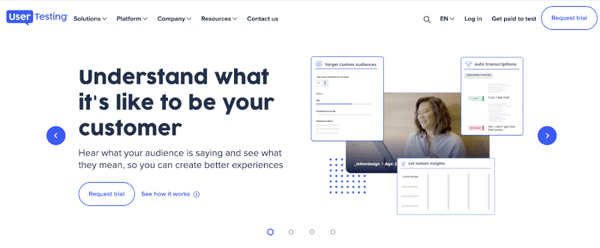
Price: The specific price is unlisted, but according to PollthePeople, "They offer tests that cost $49 per test, but only if you’re testing with 15 users or less." Three plans are available and the price for varies depending on the number of users, types, and features.
Hotjar is another tool that focuses on collecting website feedback from your customers.
It's most widely known for showing you the "hot spots" on your webpages — where users are spending most of their time, which buttons they click on, and what they avoid — using heat maps.
But it also helps companies dig deeper with recordings and on-page feedback widgets and surveys.
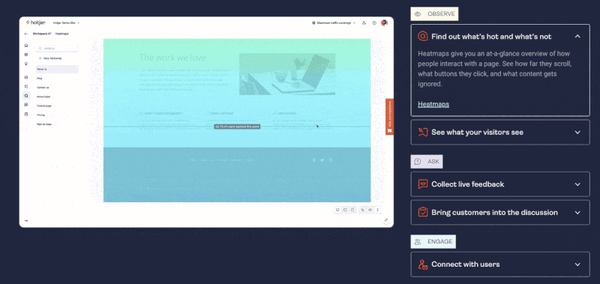
Overall, Hotjar combines visual and analytical product experience insights, user behavior analysis, and customer feedback to connect the dots between what's happening on your site and why it happens.
This information can then be used to improve the experience on your website by removing friction and giving users more of what they like.
Price: Free to get started, then starting at $32 per month depending on the plan
Context is top priority with Qualaroo. It is a survey tool that strives to ask the right questions to the right users at the right time as they navigate through your website or app.
With its tools, you can target visitors based on where they are your site, who they are, how much they pay, as well as visit history (among other things) to gather actionable user insights to improve your product and performance.
Users can choose from professionally designed questions and templates or create their own. They can also create custom "nudges" with your company colors and branding for a less disruptive experience.
Price: $69-299+ per month (billed annually) depending on the plan
This may seem like an unexpected addition to our list, but if you have a large audience, Instagram Stories can be one of the most effective, free feedback tools available to your business.
Within Instagram Stories, there are a number of interactive "stickers" you can use to engage with viewers and, in this case, gather feedback. Some of the most effective are "polls" and "questions."
First, the "polls" sticker allows you to ask a question and give your viewers options to choose from, like South Asian brands HoliChic by Megha Rao and BeautyByTamanna did in these examples:

HoliChic, a clothing brand, asks its audience what color it prefers for an upcoming design, while BeautybyTamanna, a makeup artist, asks her audience what type of hands-on classic they would like her to hold.

Both of these polls allow each brand to gather feedback from their customers on which product they like more to ideally create something that will be more profitable. It also helps customers feel "heard" and, in turn, closer to the brand.
While with the "questions" sticker, you can give your viewers a question and collect open-ended answers:

Both options can also be included in "Reels" you create.
It is important to note, however, that either option will only be able to collect responses for 24 hours. So, if you don't have a large or active following, you may not collect a large enough sample size to make truly informed decisions.
Price: Free
Unlike traditional surveys where you might want to ask them a number of different questions, with Delighted you’re only going to ask them one to help you measure:
With this tool, customers receive your question via email, app or web popup, link, or in-person kiosk. They rate your product/service in one click and the result appears instantly in your dashboard.
For each option besides the kiosk, they can even add feedback in their own words if they like. It's quick and easy for your customers and gives you a quick "pulse" of how you're doing.
Need a little inspiration? Here’s a look at what an NPS email survey from IMPACT may look like:
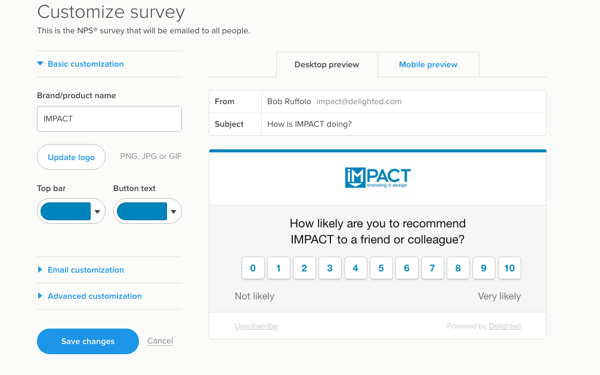
Price: Free for their basic plan, then starts at $224 per month (billed annually) depending on the plan
Are you giving a presentation? Or even giving a product demo? Wouldn’t it be cool if you could get feedback in real-time from your audience or customers?
That’s possible with Poll Everywhere.
Poll Everywhere allows you to ask questions in the following formats:
Once you’ve created your survey, you have the ability to embed the poll into a presentation or share a link, allowing your audience and customers to engage with you in real-time.
All you have to do is have your audience send a text message and the results will automatically appear on screen.

Poll Everywhere is a great tool for companies hosting events or routinely giving sales presentations. It gives your customers a quick and easy way to provide feedback so you can adapt in the moment or take note for improvements next time.
Price: Free for their intro plan, then starting at $120 per year depending on the plan
Google Forms is a great option for teams looking for easy data collection and collaboration.
Not only is the platform free, but with it you can create unlimited forms, send them to as many participants as you want, and you can even embed the form into an email or a site page.
Once people start replying, all of the data is automatically collected within a Google Spreadsheet. No need to lift a finger.
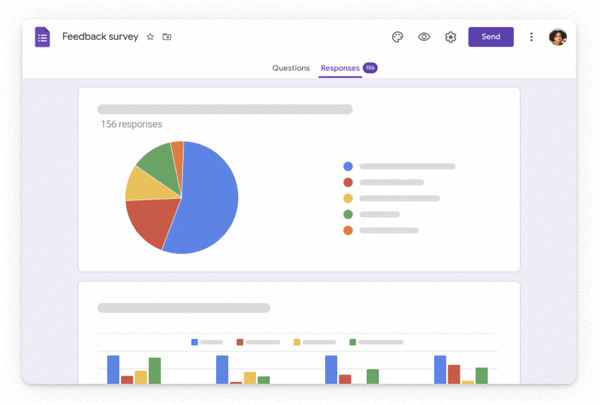
In addition to this, you can invite as many team members to collaborate and edit the survey or view the data as you like.
Plus, you can easily upload your own photo or logo and Google Forms will pick the right colors to complete the overall look and feel of your form, should you not like any of their curated themes.
Price: Free
While last on our list, SurveyMonkey is one of the best-known customer feedback tools on the market.
It's a great option for beginners as it has hundreds of expert-written templates available for you to choose from, where you need a "market research survey, customer satisfaction questionnaire, a political poll—or anything else."
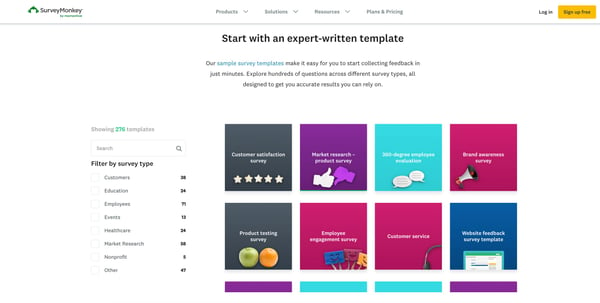
Plus, the tool basic plan is free, allowing users to send unlimited surveys with up to 10 questions (via links, email, or by embedding surveys and forms on your website), though response limits apply.
The tool is easy to use and lets you "analyze responses at scale using simple, built-in reports or advanced dashboards that you can customize and share with your team."
Price: Free for their basic plan, then starting at $39 per month
Give your customers more of what they want
At the end of the day, your business cannot thrive, let alone, survive if its customers are not happy.
Using the tools above will help you gather invaluable customer feedback on your product, services, website, sales process, and marketing among other.
These are the first-hand insights you need to give your customers more of what they want and need now and stay proactive about their needs in the future.
Want to learn more about what your customers want from your marketing? Check out our course, "4 Content Guides to Convert Leads, Close Deals, and Delight Customers" in IMPACT+!
A new option to spark even more discussion on LinkedIn - and introduce relevant connections.
The guide provides a range of stats and insights to help plan your campaigns.
The next stage for Twitter’s subscription revenue push.
For much of my soon-to-be decade at IMPACT, I held the herculean responsibility of getting everyone in our organization to contribute content to our marketing efforts.
From leadership and admin to client service and design, I worked with every member of our team (up to 65 people at its highest) to each put together a piece a least once a month.
Running a successful content marketing program is no small feat. It requires a full investment and support not only by marketing, but by your entire company.
One team that is of particular importance in your content marketing effort is sales.
Now, I know what many of you are thinking — "Sales needs to focus on selling" — and I won't lie to you; getting our sales team to contribute content was probably one of the hardest because of this belief.
The immortal words of Alec Baldwin in 1992's Glengarry Glen Ross
But this sales-needs-to-focus-only-on-selling mindset is increasingly outdated.
You see, modern buyers are more averse to sales pitches than ever. They want to navigate more of their buyer's journey on their own and only interact with salespeople if its absolutely necessary.
They don't trust businesses or salespeople to have their best interests in mind. They expect salespeople to do anything to make the sale; to trick them buying something that's not right for them.
In order to overcome this stereotype and win the trust of contemporary buyers, salespeople need to pivot to focus less on pitching and more on helping. Enter content.
In a perfect world, by the time prospects engage with you in a sales conversation, they’re ready to act.
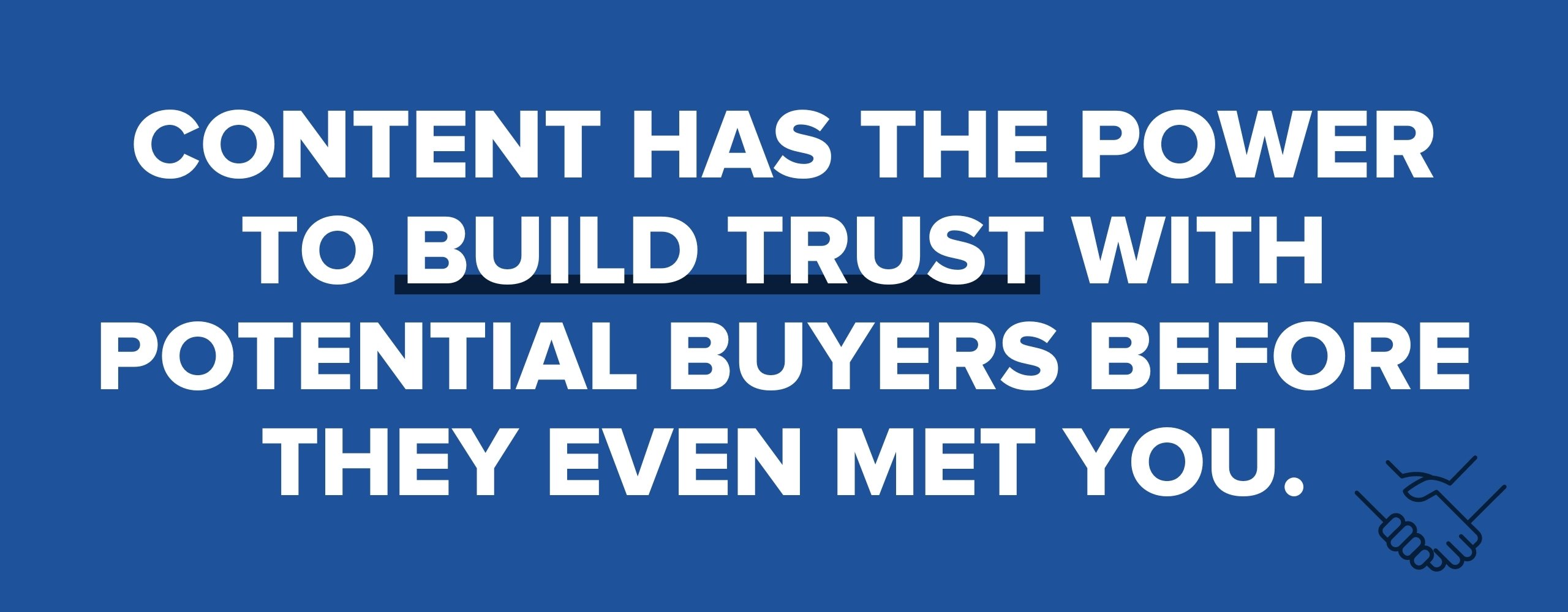
They come to your reps with a good understanding of your company and what it does and also feeling like they can trust your team to help them make the best purchase decision for their needs.
Content has the power to help you build this trust with potential buyers before they've even met you.
It lets you offer valuable information and education; to answer the questions keeping them up at night and be seen as a helpful guide.
Nobody knows this information better than your sales team.
They speak to your prospects every single day. They have detailed insights into what potential customers need to know and hear to feel comfortable making a purchase no one else does.
This is the first-hand information that will set your content apart from your competition and truly resonate with your audience.
But how do you get your sales team invested and excited about creating content for your company?
Here are six lessons I’ve learned about getting sales to lean in.
Great marketing content can be a salesperson’s best friend.
It’s like having an assistant that works 24 hours a day, 7 days a week to educate and qualify your prospects and never needs a raise or vacation.
This "on-demand" nature can be of particular value to folks in sales.

That said, to get your sales team excited about creating content, lead with how they can use content when reaching out to prospects.
Explain how offering something of value to cold prospects (like a blog article addressing a problem they're facing) is a more friendly and effective way to grab their attention than simply asking them to set up a call.
Furthermore, talk about how sales reps can use content in the sales process (a practice we call assignment selling) to address questions or combat objections buyers might have as or even before they come.
Doing this helps both prospects and sales reps save time on sales calls discussing common questions and more time diving into a prospect's specific needs and goals.
Better educated, qualified leads means more efficient and effective sales conversations.

I can’t stress enough — if you want salespeople to contribute content and you’ve started with why it’s going to help them, you have got to come to them with topics that will actually educate prospects and help them close.
Nothing will kill your sales team’s enthusiasm more quickly than having them create content they’ll never see the value in. If they don’t see the clear benefit of how a topic will help them close deals, it will be like pulling teeth every time.
So how do you avoid this trap?
Ask them what questions they get most frequently in the sales process. What questions do they wish they had a resource to share when prospects asked them?
More than often these questions will relate to your price and how you compare to competitors, among other things. However, rather than assume, let your sales team brainstorm their own topics so they are fully invested in what they're helping marketing create.
Okay, so you’ve been reading so far, thinking, “this all makes sense, but my VP/CEO/COO will never in a million years sign off on my salespeople spending the requisite time to write a blog post." Or maybe it's, "my salespeople aren't writers!"
Believe me, I've heard excuses dozens of times.
But here's a solution for you: Have marketing interview your sales people.
As long as sales reps can effectively communicate their knowledge, they can be a part of the content creation process.
All they have to do, in this instance, is make themselves available for 15-30 minutes to talk through the subject matter to whoever will be creating the content.
Someone from the marketing department can then either ghostwrite an article for them, use the information to inform their work, or simply publish the interview as the article.
With this approach, your sales reps don’t have to be the ones to actually sit down and write the content.
As long as your sales team is contributing what they know to your content marketing effort, they’re doing their part to put their expertise on display and educate the market.
Great content doesn't have to be written.
If you have a salesperson or sales team that can’t or isn’t willing to write, or would rather not be interviewed, there are plenty of other ways they can contribute to your content marketing effort.
It can be a podcast, video, infographic, or webinar, to name a few. In fact, many people in your audience may prefer these mediums.

73% of people say they'd rather watch a short video than consume any other type of content. They are also twice as likely to share video content with their friends.
If your sales team doesn’t like to write, have them record videos answering common questions. You can then publish this to social media, use it as is in the sales process or on your website, or even transcribe it into article in the future.
Where there is a will, there is a way. Be flexible and work with people's strengths.
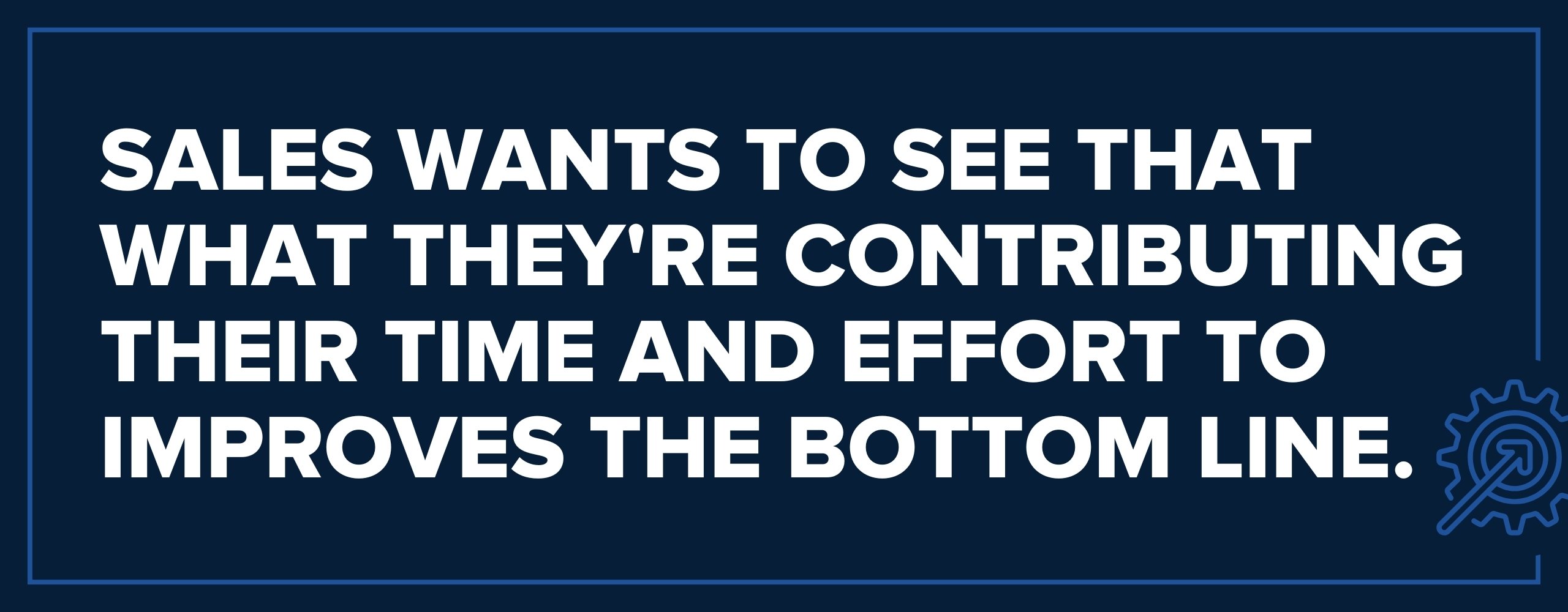
I can't say it enough: Sales wants to see that what they're contributing their time and effort to improves the bottom line.
That's why the best way to get sales excited about creating content is by showing them how content has contributed to closed deals.
Share reports of how content was consumed throughout a customer's journey to close.
For example, you can analyze how many pages or articles a customer viewed before becoming a lead or the page that brought them onto the website for the first time.
(Tools like HubSpot Attribution Reports can help you dig into this information.)
Doing this will help sales reps better understand how content fits in the big picture of closing new business and, in turn, make them more inclined to help where they can.
As essential as sales insight is to successful content, great content is essential to an effective sales process.
Each feeds the other and only when marketing and sales teams lean into this reliance will they be able to drive better leads and sales results in the coming years.
Need more help getting your sales team on board with your marketing efforts? Check our free on-demand courses, "Assignment Selling: Content Is Your Greatest Sales Tool" and "The Revenue Team Approach to Sales Enablement Content."
The option would enable you to get notifications for replies on any tweet.
Some tips to help you maximize your Pin promotions.
As a content marketer, it’s your responsibility to share the knowledge, insights, opinions, and expertise of your company with your audience — typically through blog articles, but also podcasts, videos, and so on.
You stand as a primary ambassador for your brand, guaranteeing that the content published checks all the boxes.
To do this, you need to be the creator who harnesses the knowledge of busy subject matter experts and catapults it into the world.
In many cases, this means writing content in their voice.
So, how do you do it?
One of the most challenging parts of your job will likely be ghostwriting as a team member. To do so, you need to consciously not sound like yourself, which is weird and liberating at the same time.

When I need to do this, I follow the seven steps I lay out below.
Just like with any interview, ghostwriting begins with making the subject feel comfortable with the whole process.
The subject should know the process and trust you.
Start by setting up a pre-meeting or phone call — or at least an email or Slack conversation — to set the parameters.
Assure them that they will have final say over any content published under their name and that they can be as involved in every step of the process as they’d like.
In most cases, the subject is likely exceedingly busy and, thus, will be appreciative of your help. However, wariness is not uncommon. It is the responsibility of the writer (meaning you) to put the subject at ease before any writing begins.
Other pre-writing logistics involve setting a time for an interview and agreeing on a topic, which might be something chosen by the marketing team or suggested by the subject themselves.
When writing as someone else, I create a style guide before I begin.
I know it sounds like a pain, but your future self will thank you, I promise.
Start by doing some research.
Ideally, you would have some of their written work to go by, maybe previous blog posts or articles. Even a few emails can suffice.
If your subject is a company leader, perhaps you have heard them speak at meetings or other events.
Either way, before you even write questions, start a blank document with an outline of how the person sounds, and what their writing looks like.
Here’s an example:
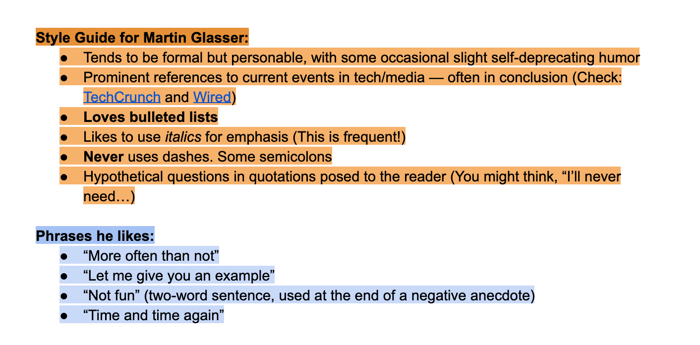
I try to get down general ideas about how the person sounds — style, tone, and phrases — as well as some common phrasings.
This helps in two ways.
The small details that I’ve accumulated in my guide can be used to drop in a phrase or tweak a sentence.
When you’ve decided on a topic, write a series of questions for your subject. I say questions, but these are really more prompts.
You want to establish a trajectory that you think the eventual article might follow, but leave room for exploration. Do the necessary research to gain an understanding of the topic at hand, but be prepared for potential diversions.
Once you reach this point, prepare much the same way you would for an interview, only with more structure.
After you write your questions, run them by the subject. However, when ghostwriting, put the questions into an outline under headings that will become H2s in the final piece.
For example:
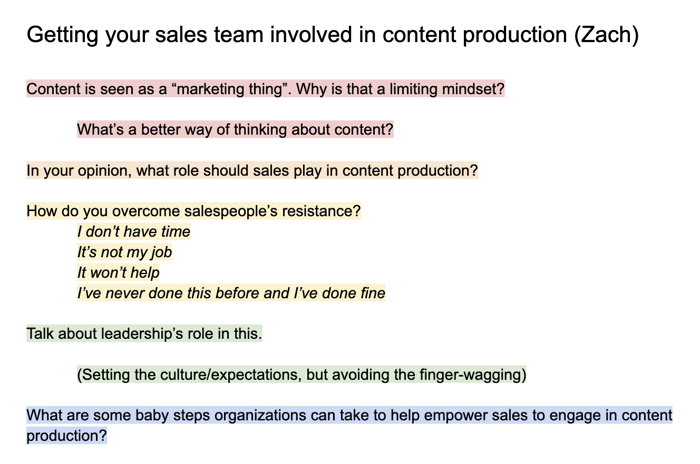
You can see I've laid out my topics and the order — as well as some notes.
In general, we'll both keep this document open while we’re talking and it becomes a sort of road map that we can each check as needed.
I’ve written elsewhere about the skills necessary to complete great interviews. The same rules apply here, but the interview itself feels a bit looser.
When interviewing for a ghostwritten piece, try to feel more comfortable following tangents. A standard interview demands cogent, well-crafted questions, but an interview for a ghostwritten piece can be more like a discussion.
In turn, the subject tends to feel more at ease — and the process will feel more collaborative.
When I interview for ghostwriting, I will frequently jump in to ask for clarification, push the discussion in a direction that feels essential, or keep us from running too long.
Honestly, the shorter the better.

In order to prevent biting off more than you can chew, I recommend not doing more than a 30-minute interview. A shorter interview keeps the topic manageable.
I always record the interview and use a service (like Rev) to prepare a transcript.
After you’ve assembled your style guide, your transcript, and any other information you need, you should begin drafting.
My earnest advice for drafting a ghostwritten piece is this: Don’t over-plan. Don’t overthink. Let the magic happen.
Keep your subject in mind as you pursue your topic, but don’t impede the writing process with relentless analysis.

Don’t confuse writing as someone else with producing a forgery. Although you have been asked to produce something that imitates their voice, you were given this task because of your writing ability.
Your skill should blend with their subject matter expertise in a collaboration. Sprinkle in elements that mimic the subject’s style, but remember that it is your job to help deliver their knowledge in the most effective way possible. Trust your ability.
It is critical that your subject have frequent opportunities for input. Once you’ve drafted and edited, share the document . Allow your subject to make suggestions and edits.
In my experience, subjects are so glad to have the onus of article writing removed from their busy schedule they will be tremendously appreciative of your hard work. Very rarely will you encounter a subject interested in micromanagement or trivialities.
If you have a particular section you struggled with, leave comments in the document (I recommend Google Docs for this) to help guide the feedback process.
You have been asked to write as someone else. This means your company trusts you and your voice. It is critical that you allow your subject to provide feedback on the draft, but don’t feel the need to involve them in minutiae.
Once you’ve had them approve the overall direction of the piece, you don’t need to contact them again to permit you to make minor changes, tweak formatting, add links, or amend a header.
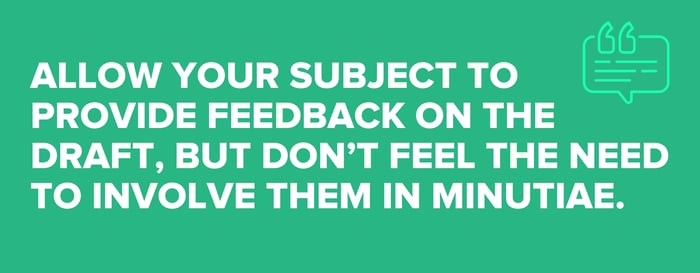
Polish the piece to your company’s standards and get it ready for publication.
No matter the reason, writing for someone else is a responsibility that requires both your skill and your judgment.
If you try to internalize some of their linguistic mannerisms and convey the information you’ve garnered from your interview, the product will naturally be a fair representation of their content and style.
It doesn't have to be scary. Trust your instincts.
As long as you write with your subject’s voice in your head, trust your own ability to structure, pace, and organize your article.
Then, when it comes time to finalize the piece and you get the go-ahead from your subject, slap his or her name on there. Your subject’s voice and expertise will be broadcast, and you will have taken a time-consuming task off of someone’s plate.
No one will be the wiser and you will have done a great service to your team.
Meta's added more resources to its Safety Center hub.
The deal will bring exclusive MLS content and integrations to the app.
The change is in line with new regulations in the region. * This article was originally published here How to make $1000/day with affili...